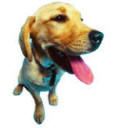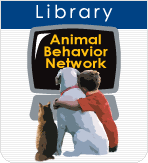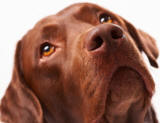|
Need Help?
|
|
Call
1-800-372-3706
to
speak to a Veterinary Behavior Technician |
|
Paws To Speak!
Member
Main Menu
|

Dog Suspension

These people are "powerful,
friendly, cookie givers!"
Pet Professional Tip
When
you the give a puppy a tasty food treat while
passing around to team members you reward
compliance and acceptance of positive handling.
You also bond the pet to the
family and to the veterinary practice. Puppies
begin to generalize that all people are
powerful and friendly. This entire process
only takes a few seconds.
|
 |
|
Help is at your
fingertips by library, email and
phone. |

Click on
Library Icon
to learn more
|
What is suspension?
Suspension is a
behavioral technique that is indicated
for puppies from 6 to 14 weeks old
that can be used by every member of a
family as well as the veterinary
practice team, starting with the
veterinary receptionist that helps the
puppy recognize the person's leadership
and, therefore, relax and go with the
flow.
How does it work?
Pick up the puppy
("suspend it") the same way you would
pick up a toddler with.jpg) each hand around the chest under the
front legs. Hold the puppy so that your
eyes are slightly higher than the pup's
eyes. Let the back legs dangle and look
directly into the puppy's eyes. The pup
should look away within a few
seconds. Relax your grip, coo and in
your best "talk to baby" voice say
something like how cute he is or, in the
veterinary setting, how lucky he is to
have an owner caring enough to bring him
to this practice. .
each hand around the chest under the
front legs. Hold the puppy so that your
eyes are slightly higher than the pup's
eyes. Let the back legs dangle and look
directly into the puppy's eyes. The pup
should look away within a few
seconds. Relax your grip, coo and in
your best "talk to baby" voice say
something like how cute he is or, in the
veterinary setting, how lucky he is to
have an owner caring enough to bring him
to this practice. .
Then give the pup a
brief hug, allow him to lick your cheek
if you want, and cradle him upside down
in your arm. If possible,
carefully hand the pup to a team member
to do the same. With permission,
give a small, tasty dog cookie.
The entire process shouldn't take more
than 10 seconds.
|
Suspension triggers the same
compliant response as when
the mother dog picks up the
puppy to move him. The
natural response from the
puppy is to relax and go
limp. |
Pet Professional Tip
Clients can
see how much the staff really love pets.
The team members get to hug a puppy, enjoy
their work, and help train the puppy. The puppy
had the most complicated and valuable experience:
.jpg) By
holding the pup
this way we remove his ability to run, hide or
bite. The pup instinctively recognized that from
this situation that the person elevating him
has taken charge. (Situational domination of the
pup.) This is reinforced by the eye
contact. (Visually communicates the pup.)
A high, friendly voice tone decreases any
threat. The hug physically controls the
pup. Cradling the pup upside down creates a
positional domination of the pup. By
holding the pup
this way we remove his ability to run, hide or
bite. The pup instinctively recognized that from
this situation that the person elevating him
has taken charge. (Situational domination of the
pup.) This is reinforced by the eye
contact. (Visually communicates the pup.)
A high, friendly voice tone decreases any
threat. The hug physically controls the
pup. Cradling the pup upside down creates a
positional domination of the pup.
The
temporary stress of suspension passes and the pup
realized, "These
powerful people could have eaten me if they wanted,
but since they didn't, they must be friendly."
This technique significantly reduces the pup's fear,
builds trust, and makes it easier for everyone in
the family or practice to handle the dog from that
day forward.
How do pups show respect?
.jpg) Puppies
demonstrate respect and submission by licking the
face of their seniors. If you "kiss" the pup, you
are demonstrating submission, which MAY confuse the
pup. If the pup doesn't lick, don't
worry. Some pups are more independent. These pups
need the suspension experience the most. If the
puppy panics, cries or struggles excessively, just
put him down. These pups will benefit the MOST from
a
Pet Behavior History Analysis
and a customized behavior modification program.
There is no time like the present to make a lasting
impact of the development of this pups personality. Puppies
demonstrate respect and submission by licking the
face of their seniors. If you "kiss" the pup, you
are demonstrating submission, which MAY confuse the
pup. If the pup doesn't lick, don't
worry. Some pups are more independent. These pups
need the suspension experience the most. If the
puppy panics, cries or struggles excessively, just
put him down. These pups will benefit the MOST from
a
Pet Behavior History Analysis
and a customized behavior modification program.
There is no time like the present to make a lasting
impact of the development of this pups personality.
|